Wetland vegetation in the Macquarie Marshes and native fish recruitment in the Wambuul – Macquarie and Cudgegong rivers were the focus of managed environmental flows in 2023–24.
Key outcomes
Under moderate weather conditions, environmental water managers worked with partner agencies and stakeholders to coordinate the delivery of water for the environment in response to conditions and environmental demands. Actions aimed to:
- maintain resilience in wetland vegetation communities of the Macquarie Marshes
- support opportunities for the breeding and recruitment of native fish in the regulated Wambuul – Macquarie and Cudgegong rivers
- secure carryover for future use should conditions turn dry
- provide and improve habitat for waterbirds, frogs, rakali, platypus and other flow-dependent fauna
- provide ecologically valuable connections from the Barwon River to the Macquarie catchment.
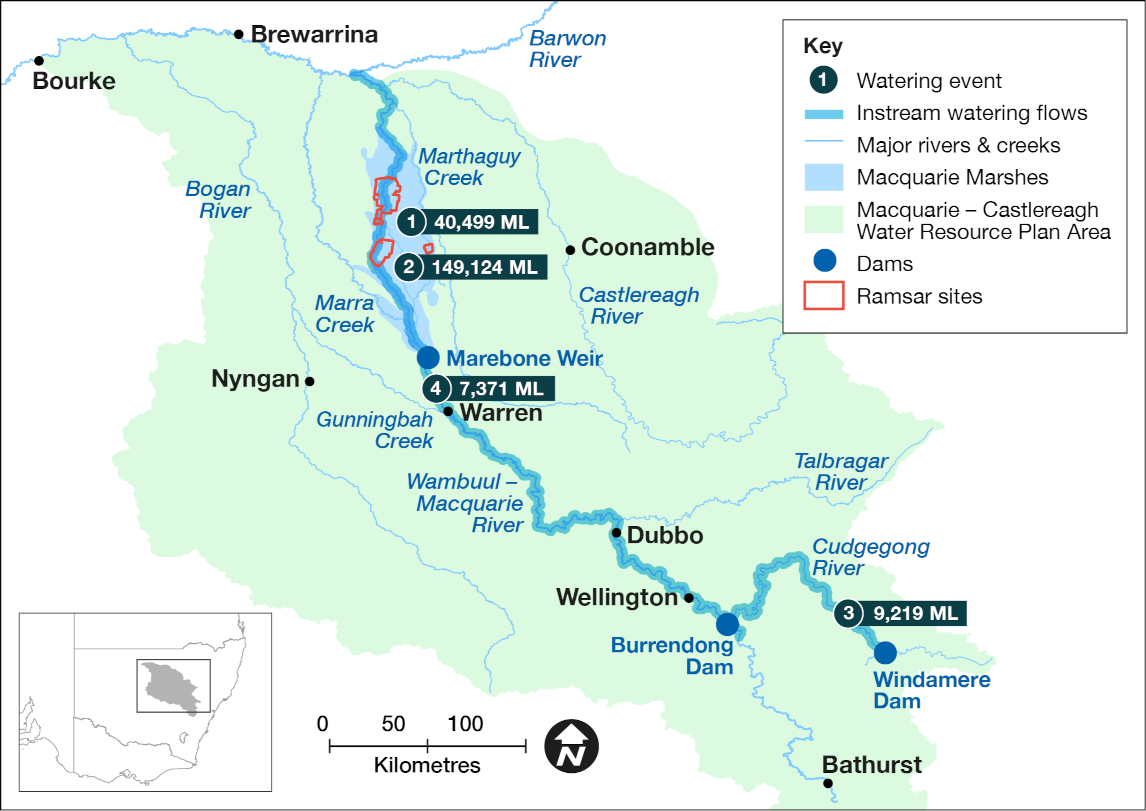
Map of the Macquarie catchment showing locations of water for the environment deliveries made in the 2023-24 water year with corresponding volumes.
Catchment conditions
After the flood years of 2021 and 2022 the catchment was generally wet and Macquarie Marshes wetlands were in good condition leading into the start of the water year in winter 2023. Rainfall in the Macquarie and Cudgegong catchments was below average over winter and spring 2023. Conditions were warm and dry.
This changed in November 2023, with rainfall at or above average for the remainder of the water year. This created a series of flow events over summer 2023–24 and autumn 2024.
Partnering with Aboriginal peoples
The Healing Country program aims to find ways to better include the voice of the Aboriginal community in discussions about annual environmental watering priorities. This would improve shared benefits for the environment and cultural places, values and interests.
In the 2023–24 water year, Healing Country program staff and environmental water managers organised workshops with various Aboriginal community groups to discuss updating the long-term water plan for the catchment. This led to:
- consideration of projects with community members like the Mudgee Local Aboriginal Lands Council
- discussions with communities about the type of Aboriginal content that may be included in the update of the Macquarie Long-Term Water Plan.
One Aboriginal community member from Trangie is on the Wambuul – Macquarie-Cudgegong Environmental Water Advisory Group and we hope another Aboriginal community member will fill at least one other seat at the table.
Watering aims
Environmental water managers prepared an annual environmental watering plan in consultation with the Wambuul – Macquarie-Cudgegong Environmental Water Advisory Group. From this plan, the Annual environmental water priorities in the Macquarie–Castlereagh catchment 2023–24 were developed in response to predicted wet weather and water availability.
Water-use objectives for the regulated Wambuul – Macquarie River were to:
- maintain resilience in wetland vegetation communities in the Macquarie Marshes
- support opportunities for the breeding and recruitment of native fish in the regulated Wambuul – Macquarie and Cudgegong Rivers
- secure carryover for future use should conditions turn dry
- provide and improve habitat for waterbirds, frogs, rakali, platypus and other flow-dependent fauna
- provide ecologically valuable connections within the catchment and between the Barwon River and the Macquarie catchment.
Water delivery
This table and chart provide a summary of 206,213 megalitres of water for the environment delivered in the Macquarie catchment during the 2023–24 watering year.
The 196,994 megalitres of water for the environment delivered in the Wambuul – Macquarie River, was complemented by more than 106,507 megalitres of tributary, flood mitigation and natural river flows, as measured at Marebone Weir.
The 9,219 megalitres of water for the environment was delivered in the regulated Cudgegong River, with an additional 4,241 megalitres of other regulated flow at Rocky Waterhole, combining with further flows from various downstream tributary creeks.
Figures were accurate at the date of publishing but may be adjusted. Watering event numbers in the table and bar chart correlate with numbers marked on the map.
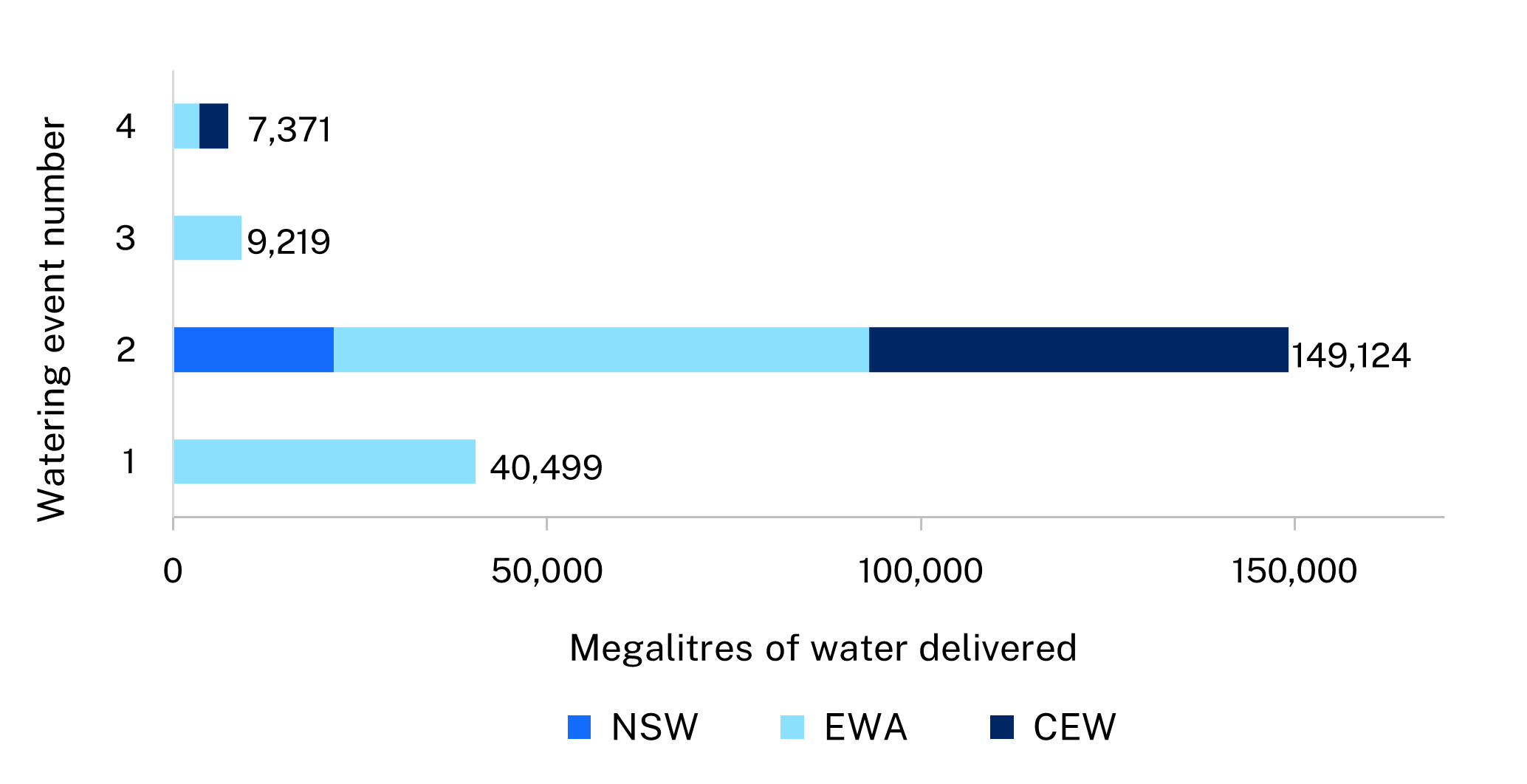
Water delivery to the Macquarie catchment in the 2023-24 water year.
Notes: EWA = environmental water allowance accrued under the water sharing plan; NSW = New South Wales licensed environmental water; CEW = Commonwealth licensed environmental water.
| Water event number | Event name | Outcomes | Start date | Finish date |
|---|---|---|---|---|
| 1 | Macquarie translucent environmental water allowance | Native vegetation, waterbirds, connectivity | 1 July 2023 | 30 June 2024 |
| 2 | Macquarie spring 2023 flow | Native vegetation, waterbirds, connectivity | 18 August 2023 | 7 December 2023 |
| 3 | Cudgegong native fish flow | Native fish | 15 October 2023 | 1 March 2024 |
| 4 | Autumn Macquarie dispersal pulse | Native fish | 7 April 2024 | 18 April 2024 |
Outcomes
In 2023–24, environmental water managers worked with the Wambuul – Macquarie-Cudgegong Environmental Water Advisory Group and the Commonwealth Environmental Water Holder to adaptively manage water to achieve annual objectives.
Although wetter catchment conditions were fading, strong inundation of about 17,000 hectares remained in the Macquarie Marshes in winter 2023. During the managed environmental water event in September and October 2023, inundation of the Macquarie Marshes extended to 29,000 hectares then slowly receded through late spring. Further flow and rainfall over autumn and early winter 2024 retained core inundation at around 10,000 hectares for a further three and a half months, with further recession recorded in late May 2023.
This inundation provided positive conditions for wetland vegetation to grow and seed, and various wetland fauna to breed including waterbirds, frogs and native fish.
Flow targets set over summer 2023–24 in the mid-Wambuul – Macquarie River were generally successful. Targets were set for a maximum of 30 cm per day rise and fall in river heights over summer to support native fish nesting. WaterNSW, working with the irrigation industry, achieved these outcomes with no environmental water required.
Autumn 2024 proved positive for native fish in mid-Wambuul – Macquarie River. Native fish dispersal and improved pre-winter water productivity were achieved through a mix of managed environmental water, tributary flows and translucent environmental water allowance pulses. These pulses continued into winter 2024.
In the lower Wambuul – Macquarie River, connectivity to the Barwon River occurred for around 200 days over the water year. Consistent flows from July to December 2023 exceeded 50 megalitres per day at Bells Bridge gauge. The gauge was used as an indicator of flows sufficient to allow large-bodied fish movement through this reach.
In the regulated Cudgegong River, a pre-breeding season productivity pulse was followed by an elevated base flow aimed to support spawning and recruitment of native fish. These flow targets were achieved without much influence by rainfall events and tributary flows.
A low-flow connection was observed between the Putta Bucca ‘Quarry Lake’ and Cudgegong River during the 500 to 550 megalitre per day productivity pulse. The lake fills from alluvial groundwater and had been strongly connected to the river during the Windamere Dam spill in the 2022–23 summer. This connection was noteworthy but not considered environmentally significant at that time.
The results of water delivery in the Macquarie catchment are represented by these charts.
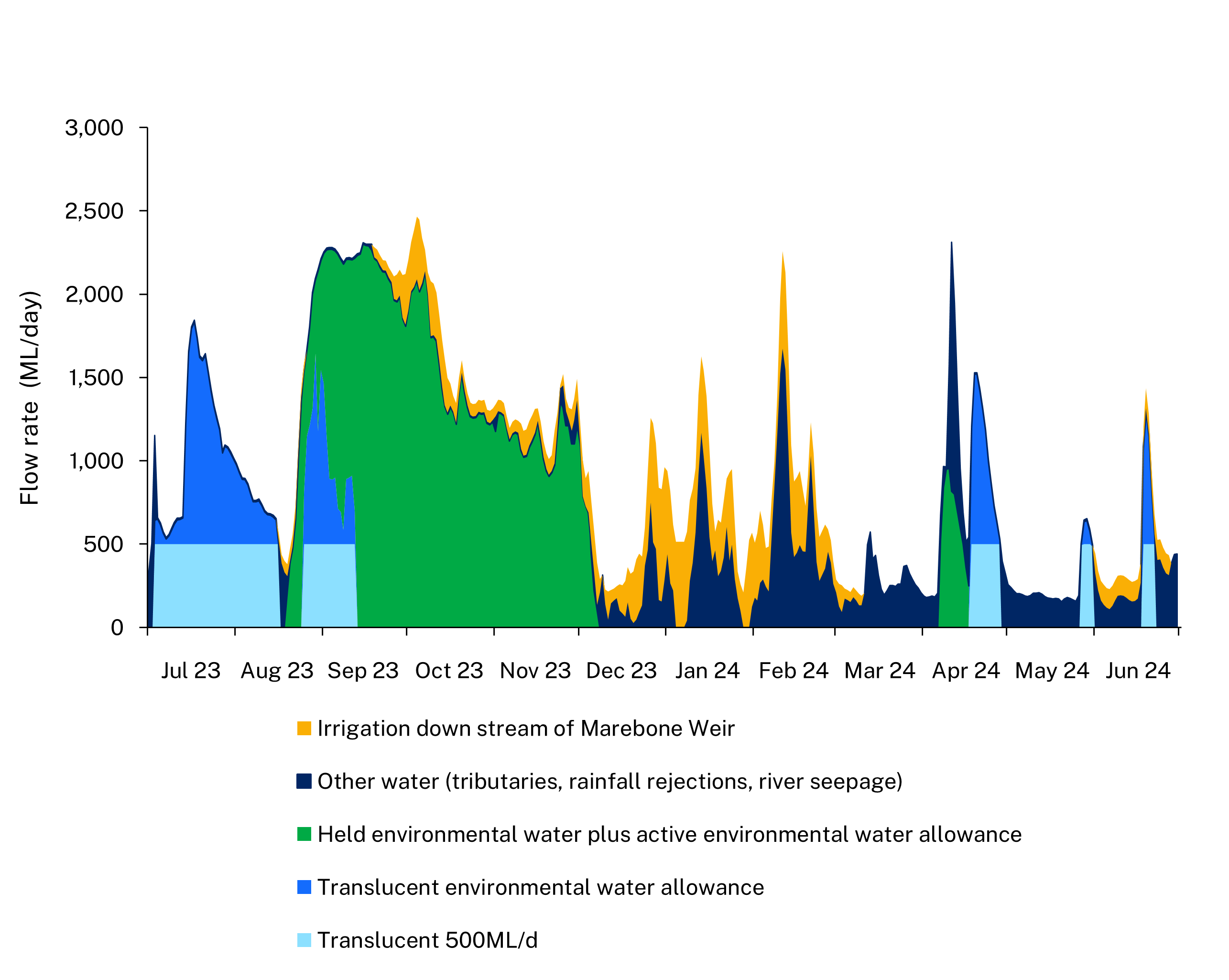
Flows in Macquarie River including delivery of environmental water from July 2023 to June 2024, which was managed for a small fresh in August to December 2023, to support native fish nesting in October to November 2023 and fish dispersal in April 2024.
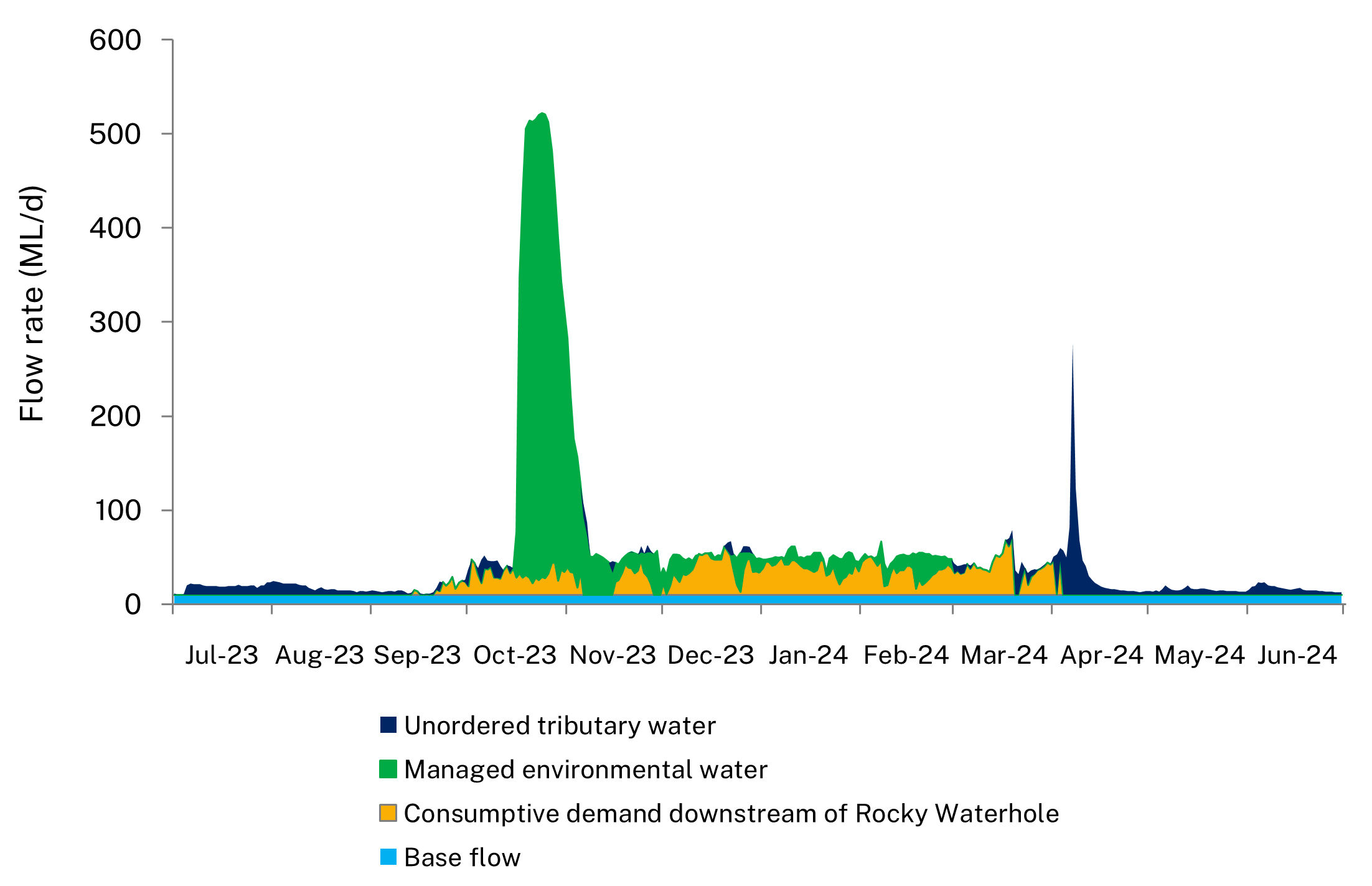
Flows in the Cudgegong River at Rocky Waterhole gauge, including delivery of environmental water between October 2023 and March 2024. The target flow of 50 ML/d was timed to coincide with warmer water which is better for native fish breeding.
Case study: a fantastic first for the fish of the Cudgegong
Spring 2023 saw the first managed use of the environmental water allowance in the Cudgegong River, downstream of Windamere Dam near Mudgee. Changes to the catchment’s Water Sharing Plan mean that water that was previously automatically triggered from Windamere Dam is managed by environmental water managers in a more targeted way.
Our environmental water management teams managed flows to the regulated Cudgegong River over 2023–24, that targeted native fish breeding and recruitment. These included:
- a 2-week pulse in October 2023 to drive river productivity, leading into the critical period for native fish breeding in the warmer months
- boosting low flows at Rocky Waterhole gauge over summer to help native fish nesting. Nesting species targeted included freshwater catfish, Murray cod and northern river blackfish.
These flows were designed in consultation with the Wambuul – Macquarie-Cudgegong Environmental Water Advisory Group, which includes NSW Department of Primary Industries – Fisheries, WaterNSW and Cudgegong River community representatives.
The October pulse reached up to 500 megalitres per day at Rocky Waterhole crossing, wetting low-level river benches and banks to boost organic carbon and food sources in the river. Vehicle access was maintained across the river.
The elevated summer flows provided a stable flow of over 50 megalitres per day. This maintained more areas for fish nesting and supported newly hatched larval and juvenile fish by providing them with an opportunity to grow before winter. Water temperature above Mudgee was generally between 20 and 25 degrees Celcius from December 2023 to March 2024, which is critical as temperature is a key driver for fish recruitment and growth.
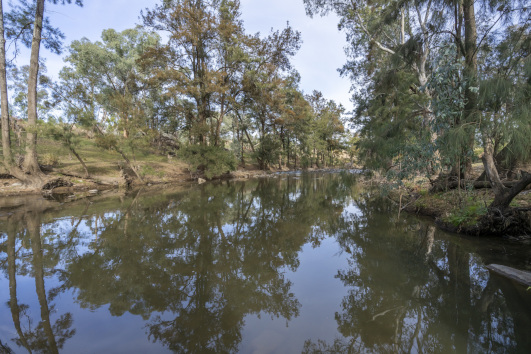
Cudgegong River in the Macquarie catchment